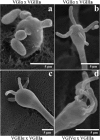Spores as infectious propagules of Cryptococcus neoformans
- PMID: 19620339
- PMCID: PMC2747963
- DOI: 10.1128/IAI.00542-09
Spores as infectious propagules of Cryptococcus neoformans
Abstract
Cryptococcus neoformans and Cryptococcus gattii are closely related pathogenic fungi that cause pneumonia and meningitis in both immunocompromised and immunocompetent hosts and are a significant global infectious disease risk. Both species are found in the environment and are acquired via inhalation, leading to an initial pulmonary infection. The infectious propagule is unknown but is hypothesized to be small desiccated yeast cells or spores produced by sexual reproduction (opposite- or same-sex mating). Here we characterize the morphology, germination properties, and virulence of spores. A comparative morphological analysis of hyphae and spores produced by opposite-sex mating, same-sex mating, and self-fertile diploid strains was conducted by scanning electron microscopy, yielding insight into hyphal/basidial morphology and spore size, structure, and surface properties. Spores isolated by microdissection were found to readily germinate even on water agarose medium. Thus, nutritional signals do not appear to be required to stimulate spore germination, and as-yet-unknown environmental factors may normally constrain germination in nature. As few as 500 CFU of a spore-enriched infectious inoculum (approximately 95% spores) of serotype A C. neoformans var. grubii were fully virulent (100% lethal infection) in both a murine inhalation virulence model and the invertebrate model host Galleria mellonella. In contrast to a previous report on C. neoformans var. neoformans, spores of C. neoformans var. grubii were not more infectious than yeast cells. Molecular analysis of isolates recovered from tissues of infected mice (lung, spleen, and brain) provides evidence for infection and dissemination by recombinant spore products. These studies provide a detailed morphological and physiological analysis of the spore and document that spores can serve as infectious propagules.
Figures






References
-
- Baker, R. D. 1976. The primary pulmonary lymph node complex of cryptococcosis. Am. J. Clin. Pathol. 65:83-92. - PubMed
-
- Barchiesi, F., M. Cogliati, M. C. Esposto, E. Spreghini, A. M. Schimizzi, B. L. Wickes, G. Scalise, and M. A. Viviani. 2005. Comparative analysis of pathogenicity of Cryptococcus neoformans serotypes A, D and AD in murine cryptococcosis. J. Infect. 51:10-16. - PubMed
Publication types
MeSH terms
Grants and funding
LinkOut - more resources
Full Text Sources
Other Literature Sources
Research Materials

